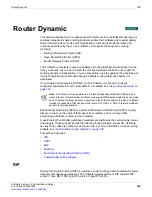
Router Static
Routing concepts
FortiGate Version 4.0 Administration Guide
01-400-89802-20090424
279
•
Another method is to manually change the priority of both of the routes. If the next-hop
administrative distances of two routes on the FortiGate unit are equal, it may not be clear
which route the packet will take. Configuring the priority for each of those routes will make
it clear which next-hop will be used in the case of a tie. You can set the priority for a route
only from the CLI. Lower priorities are preferred. For more information, see the
All entries in the routing table are associated with an administrative distance. If the routing
table contains several entries that point to the same destination (the entries may have
different gateways or interface associations), the FortiGate unit compares the
administrative distances of those entries, selects the entries having the lowest distances,
and installs them as routes in the FortiGate forwarding table. As a result, the FortiGate
forwarding table contains only those routes having the lowest distances to every possible
destination. For information about how to change the administrative distance associated
with a static route, see
“Adding a static route to the routing table” on page 284
Route priority
After the FortiGate unit selects static routes for the forwarding table based on their
administrative distances, the priority field of those routes determines routing preference.
You configure the priority field through the CLI. The route with the lowest value in the
priority field is considered the best route, and it is also the primary route. The command to
set the priority field is:
set priority <integer>
under the
config route static
command. For more information, see the
.
In summary, because you can use the CLI to specify which sequence numbers or priority
field settings to use when defining static routes, you can prioritize routes to the same
destination according to their priority field settings. For a static route to be the preferred
route, you must create the route using the
config router static
CLI command and
specify a low priority for the route. If two routes have the same administrative distance and
the same priority, then they are equal cost multipath (ECMP) routes.
Since this means there is more than one route to the same destination, it can be confusing
which route or routes to install and use. However, if you have enabled load balancing with
ECMP routes, then different sessions will resolve this problem by using different routes to
the same address. For more information, see load balancing in
Blackhole Route
A blackhole route is a route that drops all traffic sent to it. It is very much like /dev/null in
Linux programming.
Blackhole routes are used to dispose of packets instead of responding to suspicious
inquiries. This provides added security since the originator will not discover any
information from the target network.
Table 42: Default administrative distances for routing protocols
Routing protocol
Default administrative distance
Direct physical connection
1
Static
10
EBGP
20
OSPF
110
RIP
120
IBGP
200
Содержание Gate 60D
Страница 678: ...Reports Log Report FortiGate Version 4 0 Administration Guide 678 01 400 89802 20090424 http docs fortinet com Feedback...
Страница 704: ...Index FortiGate Version 4 0 Administration Guide 704 01 400 89802 20090424 http docs fortinet com Feedback...
Страница 705: ...www fortinet com...
Страница 706: ...www fortinet com...

































